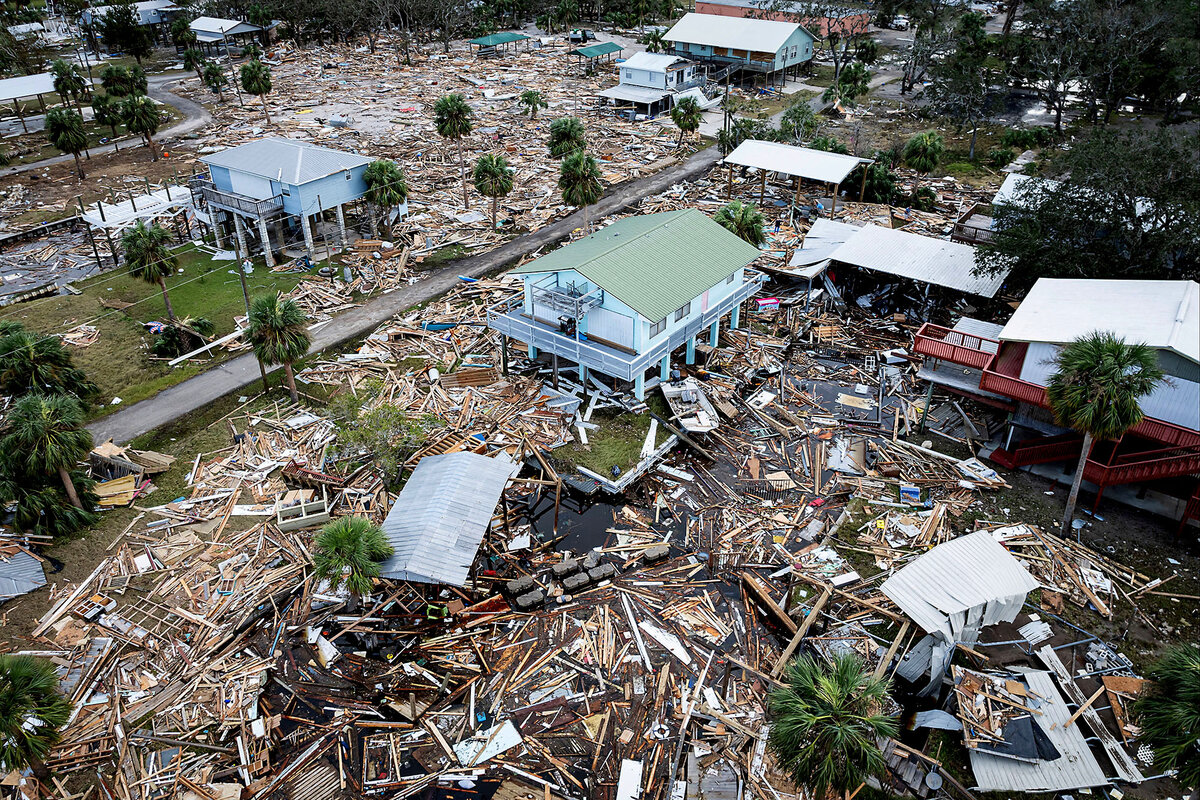Helene’s powerful floods prompt urgent relief efforts – and a wake-up call
Communities across the U.S. southeast are reeling from devastation left by what scientists say is, in effect, a new type of storm – one whose destructive force is felt far more broadly, and much farther inland, than that of typical hurricanes of the past.
Hurricane Helene crashed into Florida’s Big Bend coast as a Category 4 storm Thursday night, leaving scenes of battered houses and flooded communities by the coast. But its damage is most severe in places where people were neither expecting nor well prepared for a tropical deluge – in particular, mountainous North Carolina, where flood waters swept away entire neighborhoods, downed power and water systems, and crushed roads that connected residents.
More than 100 people have lost their lives in the storm, according to officials, and hundreds are missing. About 2 million remain without power, and tens of thousands are still without potable water. Officials’ immediate focus is on recovery and relief. But a lesson for the future is also sinking in: The storm we didn’t know to be ready for is, increasingly, the kind of storm we need to be ready for.
Indeed, Helene’s rapid intensification and stunning destruction in places once considered “climate havens” revealed what scientists have long warned are stark vulnerabilities in American infrastructure and policy at a time when global warming is exacerbating extreme weather. The storm’s aftermath has also highlighted the sort of resilience experts say will be needed to rebuild and prepare for a warmer future.
Still an alarming situation
In Cedar Key, Florida, where Helene crashed into the coast and sent a storm surge of more than 9 feet above the normal high tide line, people shared water bottles and snacks, and helped each other move debris into piles. In Augusta, Georgia, a region that counted at least 21 deaths caused by the storm, neighbors joined together to try to move fallen trees by hand. In the hill communities around Asheville, North Carolina, cut off from surrounding areas by landslides and roadways crushed by rushing water, friends shared power, gas-fueled grills, and the rare cellphone connectivity.
“Neighbors are coming out into the street to talk to one another,” says Greg Lambert, an architect who lives in the Oteen area of Asheville, just south of Interstate 40, portions of which collapsed in the storm. “It’s unifying, in a way.”
But the situation is also still alarming, he says. The main roads in and out of his city are closed to all but emergency traffic, and many hamlets are cut off from the main population center – islands within an island, as one commentator put it Sunday. Reaching these areas is – and will continue to be – a huge challenge, officials say; relief efforts are employing everything from helicopters to mules in order to reach stranded residents.
Although Mr. Lambert says he saw power crews working to repair poles and clear the many downed trees, the regional energy company, Duke Energy, said in a statement Sunday that it could be days before all customers have power restored. And throughout the city, few people have potable water.
“Extensive repairs are required to treatment facilities, underground and aboveground water pipes, and to roads that have washed away which are preventing water personnel from accessing parts of the system,” the city announced in a statement Saturday. “Although providing a precise timeline is impossible, it is important to note that restoring service to the full system could potentially take weeks.”
Federal Emergency Management Agency Administrator Deanne Criswell said Sunday that the Army Corps of Engineers is helping to restore water service, and that FEMA has search and rescue teams working in western North Carolina and is working to bring in satellite communications for residents without cell service.
“I don’t know that anybody could be fully prepared for the amount of flooding and landslides that they are experiencing right now,” she said on the television show “Face the Nation.”
Preparing for risks in new places
The multistate nature of the storm also makes recovery efforts extra challenging, she says. Nearly a million people lost power in South Carolina, where at least 25 people died in the storm, according to officials. Atlanta received what state climatologist Bill Murphy said was an “unprecedented” 11.12 inches of rainfall in a 48-hour period.
But in some ways, preparing for the unprecedented is exactly what climate researchers have been encouraging communities to do for years. Astrid Caldas, a senior climate scientist for community resilience at the Union of Concerned Scientists, warned in a press release last week that Helene was supercharged by high ocean temperatures made hundreds of times more likely because of climate change. And repeatedly, she and others have said that the impacts of storms can extend to areas beyond those typically thought of as “at risk” for hurricanes.
“Asheville is over 2,000 feet above sea level, and ~300 miles away from the nearest coastline. No place is safe from climate change,” wrote Lucky Tran, director of Science Communication and Media Relations at Columbia University, on the social media platform X.
And many worry that governmental policies have not caught up with this “everywhere” risk.
Most homeowners’ insurance policies, for instance, do not cover flooding damage. And while the federal government requires homeowners who live in FEMA-designated high flood risk areas to purchase flood insurance, much of the inland flooding that has occurred in recent years is outside those maps. That’s certainly true in western North Carolina.
“I don’t think that most people who move to the mountains expect to buy flood insurance,” says Mr. Lambert.
Rebuilding in Cedar Key, Florida
Even in areas where residents know flooding is a risk, insurance can be problematic. Increasing numbers of people here are deciding that premiums are just too high, says Heath Davis, resident and former mayor of Cedar Key, a tiny barrier island on Florida’s northern Gulf Coast. Many Cedar Key homeowners have chosen to “roll the dice” and go without insurance, he says. Of the insured homeowners on the island, he guesses that very few have a separate flood insurance policy.
“I don’t know anyone who is properly insured,” he says.
Hurricane Helene is the third major storm to barrel through Florida’s northern Gulf Coast in just over a year. And due to Cedar Key’s precarious position in the Gulf, many homes and businesses on the island don’t currently qualify for home or flood insurance. If insurance is obtainable, monthly premiums for flood insurance alone can cost as much or more than a typical monthly mortgage payment, Mr. Davis says.
Hurricane Helene sent several feet of water coursing through Mr. Davis’ own home. It hadn’t been eligible for insurance, he says, because it was older and not built to modern hurricane code. Making the improvements necessary to change that would have cost more than the home was worth, he says.
Now he and his wife will have to tear it down and rebuild from scratch.
Other Cedar Key homeowners find themselves in the same position. Even those whose homes are eligible for flood insurance often choose to go without it, due to “astronomical” premiums, says City Commissioner Jeff Webb. A common sentiment among islanders, he says, is that “Premiums are so expensive you might as well save the money and use it on repairs.”
On Sunday, three days after the storm, the island is quiet. There are some homes and shops with their innards still strewn about them; others squat behind organized piles of debris. Jordan and Shannon Keeton work around their home on one of the island’s highest points, where it escaped the flood damage that ravaged homes even just down the street. Their restaurant wasn’t so fortunate.
The shell of 83 West, one of Cedar Key’s biggest restaurants, sits on Dock Street, a short drag lined with other seafood eateries and touristy gift shops. The fact that it’s built over the water renders it uninsurable for flood or wind damage.
After Hurricane Hermine in 2016, the Keetons had to close for about eight weeks. After Idalia in 2023, they closed for 13 weeks. After Debby this summer, they closed for 3 weeks. Now, they’re closed for the foreseeable future.
“It’s a lot of unknowns,” says Ms. Keeton. After Hurricane Idalia, the Keetons applied for a loan through the U.S. Small Business Administration to help with recovery costs, one of the only options available to them. Without an insurance policy on their business, they used their mortgage to back the loan. Now, they’re worried that paying it back will mean losing their house.
When water and sewer services will return to the island is another open-ended question.
“They always tell us to ‘Build back better,’” says Mr. Keeton. “It’s like, How can I do that? I’m over my head right now in debt.”
The struggle to insure their homes and businesses is not new for Cedar Keyans. However, Mr. Davis says that the island is a “magnet for resilient people from all walks of life.”
And the storm damage clearly shows what needs to be done to improve the island’s resilience. It “shows new residents the path forward,” says Mr. Davis. “You have to think about it that way, otherwise it gets too sad.”
Stephanie Castellano reported from Cedar Key, Florida, and Stephanie Hanes from Ossipee, New Hampshire.






























